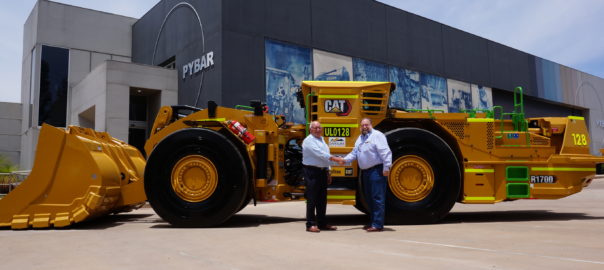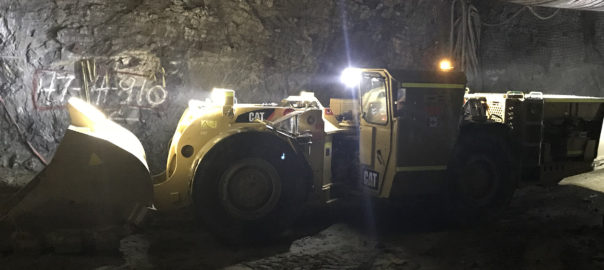PYBAR has taken a step closer to advanced underground automation at the Dargues gold mine in New South Wales, Australia, with the arrival of a second new Cat® R1700 underground LHD at the Diversified Minerals-owned site.
The new loader visited the PYBAR head office in Orange, en-route to the mine site, where it was met by executives and senior management from PYBAR and WesTrac.
The first of two new R1700s purchased for Dargues from WesTrac was commissioned at the mine during August and the company, in November, announced that the underground loaders were undergoing staged testing that will see them move towards improved automation in early 2020.
Dargues is owned by Diversified Minerals, an associated company of PYBAR Mining Services. The mine is expected to have a 355,000 t/y capacity gold processing facility comprising crushing, milling, flotation and filtration circuits and produce a sulphide concentrate for export. This could see Dargues produce an average of 50,000 oz/y of gold in the first six years of production.
The new machines are equipped with Caterpillar’s next generation Command for underground technology, giving them automation capabilities that will allow them to be driven via tele-remote from the surface from early-2020. This will realise significant productivity, efficiency and safety gains, according to PYBAR.
Command is part of the Cat Minestar™ integrated suite of offerings designed specifically for mining, PYBAR said.
PYBAR Chief Technology Officer, Andrew Rouse, said: “With the second loader now on site we will complete the tele-remoting set up in time for stoping early next year.
“Our intention is to be able to tele-remote from the surface from the outset when both loaders go into full operation. It’s a milestone all three teams (Caterpillar, PYBAR and WesTrac) have been working towards and will deliver.”
The new loaders were purchased after trials at the Vivien gold mine in Western Australia during 2017, PYBAR said. These trials delivered impressive results, including quicker bucket loading, faster cycle times, greater payloads and less fuel burn, according to PYBAR.
PYBAR said: “These benefits were further highlighted when the Cat R1700 was tested against the R1700G at Vivien (owned by Ramelius Resources) in June 2018, prompting PYBAR to place the order for the new loaders.”
Rouse added: “We were extremely impressed with performance of the new loader during testing. With the knowledge gained from the activity at Vivien, we were able to carry out a rigorous analysis around the loader combinations required for the Dargues operation with the R1700 proving to be the most cost effective.”
Since the first new loader has been put into operation, PYBAR has been preparing for advanced automation through the use of the traction control and Autodig features on the new machines, it said. The feedback has been very positive with full buckets consistently being achieved, the company added.
“The Command technology enables remote operation from the surface or underground, providing productivity and efficiency gains, improved safety of personnel, more accurate tunnel navigation, and reduced machine damage,” PYBAR said.
Caterpillar’s Commercial Manager for Underground Technology, Randy Schoepke, said PYBAR has long seen the value of being on the “leading edge of technology” as a contractor and an owner miner.
“The new Cat R1700 loader will be a huge complement to their technology portfolio leveraging the most advanced features in the industry,” he said.
“The R1700 features of traction control, live payload, Autodig, and ride control will not only provide operator comfort and productivity but also be leveraged by Caterpillar’s latest generation of Command for Underground, Caterpillar’s remote and autonomous control system.”
Schoepke concluded: “When there is a requirement to remove the operator from the underground environment, the technology allows safety and utilisation to be taken to the next level. We look forward to our continued work with PYBAR on this project.”
WesTrac General Manager of Mining Sales, Jody Scott, said this development was the culmination of more than two years work with PYBAR to “identify and test the technology that will have the most impact and benefits for them and their clients”.
He added: “Extensive testing has enabled us to fully evaluate the challenges posed by the harsh underground environments in which the machines are required to operate. It has also allowed us to set up the machines to get the most out of their automation and tele-remote capabilities.”








